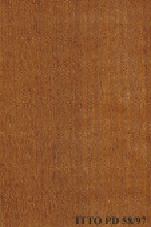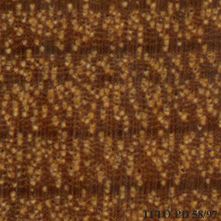
MOABI (Baillonella toxisperma)
Nom commercial
Moabi
Nom scientifique (avec auteur)
Baillonella toxisperma Pierre
Famille
SAPOTACEAE
Noms communs (pays)
M'foi (Gabon); Adjap (Equatorial Guinea); Moabi (Congo); Adjap (Cameroon); Moabi (Angola); Ulumba; Orere; Nyabi; Ngulube; Nduku wa dijondo; Mwabi; Muyabi; Mudia; Muabi; Kungulu; Djave; Cungulo; Adjap; African pearwood (United Kingdom); Muamba jaune (Zaire); M`foi (Gabon); Dimpampi (Congo); Ayap (Equatorial Guinea); Ayap (Cameroon); Adza (Gabon); Njabi (Cameroon); Njabi (Nigeria); Moabi
Synonymes du nom scientifique (avec auteurs)
Mimusops obovata Pierre ex Engl.; Mimusops djave (Laness.) Engl.; Bassia djave Laness.; Baillonella djave Pierre
DESCRIPTION DE L'ARBRE
Description botanique
The tree reaches a height of more than 50 m with straight cylindrical boles to 32 m in length. The trunk diameter attains up to 200 cm, sometimes even reaching more than 300 cm. Butt swelling is reported in older trees. Log is banned for international tra
Habitat naturel
Baillonella toxisperma is found in primary evergreen and old secondary rainforest, often in small patches on dry or moist soils.
Répartition naturelle
Found in the dense equatorial forests of Africa.
IDENTIFICATION DU BOIS
Description anatomique du bois
Wood diffuse porous. Vessels in dendritic pattern. Vessels in diagonal and/or radial pattern. Occasionally vessels exclusively solitary (over 90%). Tangential diameter of vessel lumina 100 to 150 micras (small). Tyloses common. Non-vestured pits. Vessels per mm2 Axial parenchyma in continuous tangential lines or fine bands. Non-crystals in axial parenchyma cells. 5 to 8 cells per parenchyma strand. Axial parenchyma in narrow bands on lines up to 3 cells wide. Axial parenchyma bands more than 3 cells wide. 4 to 10 rays per mm (medium). Rays non-storied. Rays 1 to 4 seriate. Silica bodies in upright and/or square ray cells. Heterogeneous rays and/or multiseriate heterogeneous rays. Non-septate fibers. Fibers with simple to minutely bordered pits.
-
 Vue macroscopique du bois (plan tangentiel)
Vue macroscopique du bois (plan tangentiel)
-
 Vue microscopique d'une section transversale du bois
Vue microscopique d'une section transversale du bois
Disponibilité
Statut CITES
Unrestricted
DESCRIPTION GÉNÉRALE DU BOIS
Teinte
The sapwood is dark grey to pinkish grey, it has a thickness of 4 to 6 cm. The heartwood is pink brown to red brown, it is clearly demarcated. The silver figure is fine (hardly visible).
Index de Teinte (1 = Noir, 7 = Jaune clair)
3
Grain
Straight or slightly interlocked, sometimes with an influence on further processing operations.
Texture
This wood has a somewhat fine texture.
Luster
It is reported to be low in luster.
Durabilité naturelle
Very durable to decay; without preservative treatment. This species is especially suited for all the uses with risks of permanent or long-lasting humidification. Resistant to termites attack. Heartwood is resistant to Lyctus attacks.
Index de durabilité naturelle (1 = Très élevée, 7 = Très faible)
1
Tensions internes de croissance
Residual growth stresses are absent.
Teneur en silice
Silica Content: Silica is present. Amounts over 0.05% may affect wood processing. Silica Value: 0.19
Résistance à l'imprégnation
Difficult to treat with only a low penetration of the preservative products.
PROPRIÉTÉS PHYSIQUES DU BOIS
Densité basale ou gravité spécifique (poids anhydre/vol. saturé) (g/cm³)
0.77
Densité sèche à l'air (poids et volume à 12%TH) (g/cm³)
0.87
Retrait tangentiel total (saturé à 0%TH) (%)
8.7
Retrait radial total (saturé à 0%TH) (%)
6.5
Défauts dus au séchage
Ease of Drying: Drying is moderately difficult to difficult; special care is systematically needed. Drying Defects: Risks of distortions. Kiln Schedules: Schedule proposed as a reference by comparison with well known species taking into account to the general technological behavior of this species.
Calendrier de séchage en séchoir recommandé
FR-4
Ratio de stabilité dimensionnelle (% retrait tangentiel total/% retrait radial total)
1.3
Calendrier de séchage en séchoir
http://www.tropicaltimber.info/wp-content/uploads/2015/09/KD_French.pdf
PROPRIÉTÉS CHIMIQUES DU BOIS
PROPRIÉTÉS MÉCANIQUES DU BOIS
Résistance à la flexion (module de rupture_MOR) 12%TH (kgf/cm²)
1453
Rigidité (module d'élasticité_ MOE) 12%TH (kgf/cm²)
214516
Résistance à la compression parallèle à la fibre 12%TH (kgf/cm²)
750
Résistance à la compression perpendiculaire à la fibre 12%TH (kgf/cm²)
107
Résistance au cisaillement (radial) 12%TH (kgf/cm²)
124
Dureté Janka (latérale) 12%TH (kgf)
949
Dureté Janka (extrémités) 12%TH (kgf)
1003
OUVRABILITÉ
Sciage
Sawing of this species requires powerful equipment.
Coupe de placage de déroulage
Suitable for slicing, also suitable for peeling if treated.
Placage tranche
Suitable for slicing, also suitable for peeling if treated.
Effet d'émoussement
Severe blunting effect; stellited blades for sawing and carbide tools for machining are recommended.
Usinage
It needs powerful tools for processing. Possible difficulties caused by interlocked grain are reported.
Rabotage
Moderately easy; tools must be cautiously sharpened.
Moulurage
Moderately easy; tools must be cautiously sharpened.
Tournage
30
Perçage
Moderately easy; tools must be cautiously sharpened.
Mortaisage
Moderately easy; tools must be cautiously sharpened.
Clouage
Pre-boring is necessary.
Collage
Difficult to glue because of high density.
Ponçage
Easy to perform; it gives good results.
Polissage
Can be polished without surface preparation.
Cintrage à la vapeur
It is well suited for wood bending uses.
Compatibilité avec outils manuels
Working with hand tools is difficult.
UTILISATIONS
UTILISATIONS FINALES (RÉSUMÉ)
HOUSING GENERAL, beams, joists, boards, flooring, parquet, frames, steps, panelling, fittings, FURNITURE AND CABINETS, luxury furniture, cabinets, PLYWOOD AND VENEER, faces, Decorative veneer, TURNING, ornaments, turned furniture, cutlery, lasts, BENDING, chairs, OTHER AND MUSICAL INSTRUMENTS, handicrafts
MEUBLES ET M. DE RANGEMENT
- 10 - Silica in Timbers
Pouters
- 11 - Prospect: The wood database
Solives
- 12 - Tropical timbers of the world. Part I-Tropical American Species
Planches
- 13 - Dry kiln schedules for commercial woods. Temperate and tropical. Section III. Latin American (Mexico, Central, and South America) Woods–Conventional Temperatures
Planchers
- 14 - Handbook of Hardwoods
Parquets
- 15 - Empire Timbers
Cadres
- 16 - Woods of the World
Marches
- 17 - Tree Conservation Database
Panneaux
- 18 - W3TROPICOS Missouri Botanical Garden
Accessoires en bois
- 19 - Silica in Timbers
MEUBLES ET M. DE RANGEMENT
- 21 - Tropical timbers of the world. Part III-Southeast Asian and Oceanian Species.
Meubles luxe
- 22 - Dry kiln schedules for commercial woods. Temperate and tropical. Section IV-Asian and Oceanian Woods
Armoires
- 24 - Empire Timbers
PANNEAUX ET PLACAGE
- 25 - Directory of Timber Trade Malaysia
Faces (de placage)
- 26 - Annual Review and Assessment of the World Timber Situation 1998-ITTO
Placage tranché
- 28 - Ministry of Agriculture, Fisheries & Forest of Fiji
Tournage
- 30 - Embassy of Honduras in Japan
Ornements
- 31 - Embassy of Colombia in Japan
Ornements
- 32 - Embassy of Cote d`Ivoire in Japan
Manches de couverts
- 33 - Embassy of Gabon in Japan
Formes à chaussures
- 34 - Embassy of Indonesia in Japan
Résistance à la flexion
- 35 - Embassy of Myanmar in Japan
Chaises
- 36 - Autoridad Nacional del Ambiente, Panama
Artisanat
- 66 - Maderas latinoamericanas. VII. Caracteristicas anatomicas. propiedades fisicomecanicas, de secado, y tratabilidad de la madera juvenil de Cordia alliodora (Ruiz & Pav. Oken.)
Please Provide Information To View Producer Information